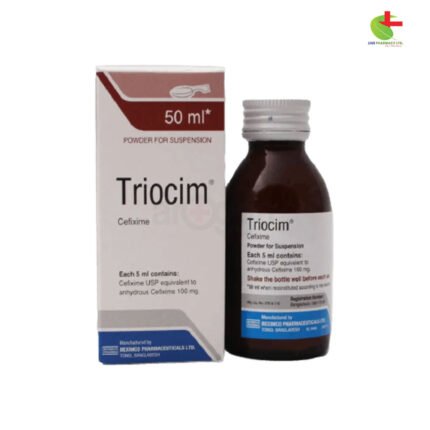

Azithrocin 50ml
185.00৳ Bottle (50ml)
- Azithrocin by Live Pharmacy, branded as Beximco Pharmaceuticals Ltd., is a potent antibiotic used to treat a range of infections, including respiratory, skin, and sexually transmitted diseases.
- Its high tissue penetration and acid stability allow for effective treatment with a single large dose.
- Azithrocin works by inhibiting bacterial protein synthesis, targeting both gram-positive and gram-negative bacteria.
- Available in oral and injectable forms, it should be used as prescribed to ensure optimal effectiveness.
 Brand
Brand
|
Beximco Pharmaceuticals Ltd |
|---|---|
 Generics
Generics
|
Azithromycin Dihydrate |
 Type
Type
|
Powder for Suspension |
Indications
Azithrocin is prescribed for a variety of infections caused by susceptible organisms. It is effective in treating:
- Lower respiratory tract infections such as bronchitis and pneumonia
- Upper respiratory tract infections including sinusitis and pharyngitis/tonsillitis
- Otitis media
- Skin and soft tissue infections
- Sexually transmitted infections in both men and women, including non-gonococcal urethritis and cervicitis due to Chlamydia trachomatis
Pharmacology
Azithrocin is a stable macrolide antibiotic, resistant to gastric acids, which allows for oral administration without the need for special protection. It is optimally absorbed when taken on an empty stomach, reaching peak plasma concentrations within 2.1 to 3.2 hours. Due to its high lipid solubility and ion trapping, azithrocin accumulates in phagocytes and is transported to infection sites, with tissue concentrations potentially exceeding plasma levels by over 50 times. Its extended half-life supports effective treatment with a single large dose, maintaining bacteriostatic levels for several days. Following a 500 mg dose, azithrocin shows a polyphasic decline in plasma levels with a terminal half-life of approximately 68 hours. Biliary excretion is the primary elimination route, with around 6% of the dose appearing in urine.
Microbiology
Azithrocin targets the 50S ribosomal subunit in bacteria, disrupting protein synthesis without affecting nucleic acid synthesis. It is effective against a broad range of microorganisms:
- Aerobic and facultative gram-positive bacteria: Staphylococcus aureus, Streptococcus agalactiae, Streptococcus pneumoniae, Streptococcus pyogenes
- Aerobic and facultative gram-negative bacteria: Haemophilus ducreyi, Haemophilus influenzae, Moraxella catarrhalis, Neisseria gonorrhoeae
- Other bacteria: Chlamydia pneumoniae, Chlamydia trachomatis, Mycoplasma pneumoniae
- Additional organisms: Bordetella pertussis, Legionella pneumophila, Peptostreptococcus species, Prevotella bivia
Dosage Oral Administration:
- Adults: 500 mg once daily for 3 days or an initial 500 mg on day 1, followed by 250 mg daily for the next 4 days. For treating sexually transmitted diseases caused by Chlamydia trachomatis, a single 1 g dose or 500 mg on day 1 followed by 250 mg daily for 2 days is recommended.
- Children: 10 mg/kg body weight daily for 3 days for children over 6 months. Dosages vary by weight: 200 mg (15-25 kg), 300 mg (26-35 kg), and 400 mg (36-45 kg). For typhoid fever, 500 mg daily for 7-10 days is advised.
Azithrocin Injection (IV Infusion):
- Community-acquired pneumonia: 500 mg daily via IV for at least 2 days, followed by oral 500 mg daily for 7-10 days.
- Pelvic inflammatory disease: 500 mg daily via IV for 1-2 days, transitioning to oral 250 mg daily for 7 days. If anaerobic bacteria are suspected, an additional antimicrobial agent should be used.
Administration
- Suspension Reconstitution: Shake the bottle, add boiled and cooled water up to the marked line, and shake until fully dissolved.
- Dosage Timing: Take Azithrocin at least 1 hour before or 2 hours after meals.
Interactions
- Antacids: Take Azithrocin at least 1 hour before or 2 hours after antacids.
- Cyclosporine: Caution is advised; monitor cyclosporine levels if co-administered.
- Digoxin: Monitor levels due to potential interactions.
- Ergot Derivatives: Avoid concurrent use due to potential risks.
- Warfarin: Azithrocin does not significantly alter warfarin effects but regular monitoring of prothrombin time is recommended.
Contraindications
Azithrocin is contraindicated in patients with hypersensitivity to macrolides or hepatic diseases and should not be used with ergot derivatives.
Side Effects
Azithrocin is generally well tolerated. Common side effects include gastrointestinal issues such as nausea, abdominal pain, and diarrhea. Rare but serious reactions may include severe hypersensitivity and liver enzyme elevations. Hearing impairment has been observed with prolonged high-dose usage.
Pregnancy & Lactation
Azithrocin is classified as Category B for pregnancy. While animal studies show no fetal harm, it should be used during pregnancy only if necessary. The presence of Azithrocin in breast milk is unknown; caution is advised for nursing mothers.
Precautions & Warnings
Serious allergic reactions, including anaphylaxis, have been reported. Use Azithrocin with caution in patients with severe renal impairment and avoid in those with liver diseases.
Overdose Effects
In cases of overdose, typical symptoms may include severe nausea, vomiting, and diarrhea. Gastric lavage and supportive care are recommended.
Storage Conditions
Store in a dry place, away from light and heat, and out of reach of children.











Reviews
There are no reviews yet.